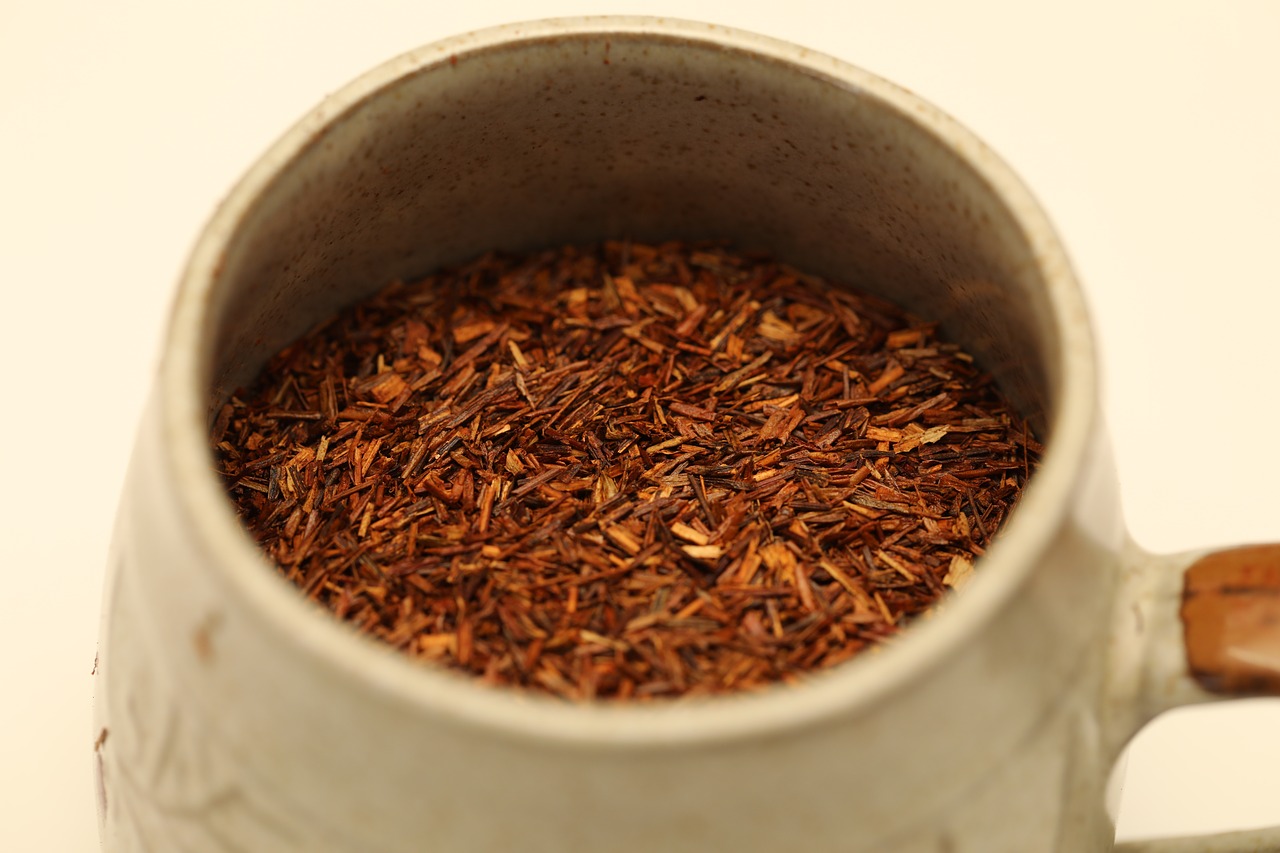Used abundantly in South Africa for centuries, rooibos tea is now becoming popular around the world for its robust taste and its health benefits alike. Known also as red tea or red bush tea, rooibos is traditionally made from fermenting the leaves of the Aspalathus linearis and prepared as black tea. However, green rooibos is a non-fermented option and though it has an earthy taste, it contains more antioxidants.
Rooibos tea is quite safe and side effects are particularly rare.
Please use moderation and care when using herbs and read our disclaimer
6784680
{6784680:GG9QAGJH},{6784680:EN7BIN7X},{6784680:VM3KP7FM},{6784680:SFWMR7P8},{6784680:B83UDPYT}
items
1
apa
0
default
asc
1447
https://seedfromhusk.com/wp-content/plugins/zotpress/
%7B%22status%22%3A%22success%22%2C%22updateneeded%22%3Afalse%2C%22instance%22%3A%22zotpress-1537d5116edb51e1c810700977a6632e%22%2C%22meta%22%3A%7B%22request_last%22%3A0%2C%22request_next%22%3A0%2C%22used_cache%22%3Atrue%7D%2C%22data%22%3A%5B%7B%22key%22%3A%22EN7BIN7X%22%2C%22library%22%3A%7B%22id%22%3A6784680%7D%2C%22meta%22%3A%7B%22creatorSummary%22%3A%22Standley%20et%20al.%22%2C%22parsedDate%22%3A%222001-01%22%2C%22numChildren%22%3A1%7D%2C%22bib%22%3A%22%3Cdiv%20class%3D%5C%22csl-bib-body%5C%22%20style%3D%5C%22line-height%3A%202%3B%20padding-left%3A%201em%3B%20text-indent%3A-1em%3B%5C%22%3E%5Cn%20%20%3Cdiv%20class%3D%5C%22csl-entry%5C%22%3EStandley%2C%20L.%2C%20Winterton%2C%20P.%2C%20Marnewick%2C%20J.%20L.%2C%20Gelderblom%2C%20W.%20C.%2C%20Joubert%2C%20E.%2C%20%26amp%3B%20Britz%2C%20T.%20J.%20%282001%29.%20Influence%20of%20processing%20stages%20on%20antimutagenic%20and%20antioxidant%20potentials%20of%20rooibos%20tea.%20%3Ci%3EJournal%20of%20Agricultural%20and%20Food%20Chemistry%3C%5C%2Fi%3E%2C%20%3Ci%3E49%3C%5C%2Fi%3E%281%29%2C%20114%26%23x2013%3B117.%20%3Ca%20href%3D%27https%3A%5C%2F%5C%2Fdoi.org%5C%2F10.1021%5C%2Fjf000802d%27%3Ehttps%3A%5C%2F%5C%2Fdoi.org%5C%2F10.1021%5C%2Fjf000802d%3C%5C%2Fa%3E%3C%5C%2Fdiv%3E%5Cn%3C%5C%2Fdiv%3E%22%2C%22data%22%3A%7B%22itemType%22%3A%22journalArticle%22%2C%22title%22%3A%22Influence%20of%20processing%20stages%20on%20antimutagenic%20and%20antioxidant%20potentials%20of%20rooibos%20tea%22%2C%22creators%22%3A%5B%7B%22creatorType%22%3A%22author%22%2C%22firstName%22%3A%22L.%22%2C%22lastName%22%3A%22Standley%22%7D%2C%7B%22creatorType%22%3A%22author%22%2C%22firstName%22%3A%22P.%22%2C%22lastName%22%3A%22Winterton%22%7D%2C%7B%22creatorType%22%3A%22author%22%2C%22firstName%22%3A%22J.%20L.%22%2C%22lastName%22%3A%22Marnewick%22%7D%2C%7B%22creatorType%22%3A%22author%22%2C%22firstName%22%3A%22W.%20C.%22%2C%22lastName%22%3A%22Gelderblom%22%7D%2C%7B%22creatorType%22%3A%22author%22%2C%22firstName%22%3A%22E.%22%2C%22lastName%22%3A%22Joubert%22%7D%2C%7B%22creatorType%22%3A%22author%22%2C%22firstName%22%3A%22T.%20J.%22%2C%22lastName%22%3A%22Britz%22%7D%5D%2C%22abstractNote%22%3A%22The%20antimutagenic%20and%20antioxidant%20potentials%20of%20rooibos%20%28Aspalathus%20linearis%29%20tea%20samples%2C%20collected%20from%20each%20of%20its%20major%20processing%20stages%2C%20were%20evaluated%20according%20to%20the%20Salmonella%20typhimurium%20mutagenicity%20test%20and%20the%20hydrogen%20donating%20ability%20and%20superoxide%20anion%20radical%20scavenging%20assays%2C%20respectively.%20Ten%20random%20samples%20were%20collected%20before%20and%20after%20fermentation%2C%20as%20well%20as%20after%20sun-drying%2C%20sieving%2C%20and%20steam%20pasteurization.%20Results%20indicated%20that%20the%20fermented%20tea%20had%20a%20significantly%20%28P%20%3C%200.05%29%20lower%20antimutagenic%20and%20antioxidant%20potential%20than%20the%20unfermented%20tea.%20Of%20the%20different%20processing%20stages%2C%20the%20most%20significant%20reduction%20in%20the%20antimutagenic%20and%20antioxidant%20property%20of%20the%20tea%20was%20found%20during%20the%20%5C%22fermentation%5C%22%20step.%20Sun-drying%2C%20sieving%2C%20and%20steam%20pasteurization%20also%20reduced%20the%20antimutagenic%20potential%20of%20the%20tea%2C%20although%20not%20to%20the%20same%20extent%20as%20the%20first%20processing%20step.%20The%20hydrogen%20donating%20ability%20was%20significantly%20increased%20after%20steam%20pasteurization%20in%20comparison%20to%20those%20of%20fermented%20and%20sun-dried%20tea.%20Pasteurization%20did%20not%20affect%20superoxide%20anion%20radical%20scavenging%20in%20comparison%20to%20fermented%20tea.%20Differences%20seem%20to%20exist%20in%20the%20antimutagenicity%20and%20antioxidant%20potencies%20of%20the%20tea%20sampled%20at%20the%20various%20stages%20during%20processing.%20A%20possible%20role%20of%20tea%20polyphenols%20in%20the%20antimutagenic%20and%20antioxdant%20activities%20of%20the%20tea%20is%20suggested%20as%20processing%20caused%20a%20significant%20reduction%20in%20the%20total%20polyphenolic%20content.%22%2C%22date%22%3A%22Jan%202001%22%2C%22language%22%3A%22eng%22%2C%22DOI%22%3A%2210.1021%5C%2Fjf000802d%22%2C%22ISSN%22%3A%220021-8561%22%2C%22url%22%3A%22%22%2C%22collections%22%3A%5B%22U8LU2X8Y%22%5D%2C%22dateModified%22%3A%222020-09-08T07%3A12%3A25Z%22%7D%7D%2C%7B%22key%22%3A%22GG9QAGJH%22%2C%22library%22%3A%7B%22id%22%3A6784680%7D%2C%22meta%22%3A%7B%22creatorSummary%22%3A%22Stalmach%20et%20al.%22%2C%22parsedDate%22%3A%222009-08-12%22%2C%22numChildren%22%3A1%7D%2C%22bib%22%3A%22%3Cdiv%20class%3D%5C%22csl-bib-body%5C%22%20style%3D%5C%22line-height%3A%202%3B%20padding-left%3A%201em%3B%20text-indent%3A-1em%3B%5C%22%3E%5Cn%20%20%3Cdiv%20class%3D%5C%22csl-entry%5C%22%3EStalmach%2C%20A.%2C%20Mullen%2C%20W.%2C%20Pecorari%2C%20M.%2C%20Serafini%2C%20M.%2C%20%26amp%3B%20Crozier%2C%20A.%20%282009%29.%20Bioavailability%20of%20C-linked%20dihydrochalcone%20and%20flavanone%20glucosides%20in%20humans%20following%20ingestion%20of%20unfermented%20and%20fermented%20rooibos%20teas.%20%3Ci%3EJournal%20of%20Agricultural%20and%20Food%20Chemistry%3C%5C%2Fi%3E%2C%20%3Ci%3E57%3C%5C%2Fi%3E%2815%29%2C%207104%26%23x2013%3B7111.%20%3Ca%20href%3D%27https%3A%5C%2F%5C%2Fdoi.org%5C%2F10.1021%5C%2Fjf9011642%27%3Ehttps%3A%5C%2F%5C%2Fdoi.org%5C%2F10.1021%5C%2Fjf9011642%3C%5C%2Fa%3E%3C%5C%2Fdiv%3E%5Cn%3C%5C%2Fdiv%3E%22%2C%22data%22%3A%7B%22itemType%22%3A%22journalArticle%22%2C%22title%22%3A%22Bioavailability%20of%20C-linked%20dihydrochalcone%20and%20flavanone%20glucosides%20in%20humans%20following%20ingestion%20of%20unfermented%20and%20fermented%20rooibos%20teas%22%2C%22creators%22%3A%5B%7B%22creatorType%22%3A%22author%22%2C%22firstName%22%3A%22Ang%5Cu00e9lique%22%2C%22lastName%22%3A%22Stalmach%22%7D%2C%7B%22creatorType%22%3A%22author%22%2C%22firstName%22%3A%22William%22%2C%22lastName%22%3A%22Mullen%22%7D%2C%7B%22creatorType%22%3A%22author%22%2C%22firstName%22%3A%22Monia%22%2C%22lastName%22%3A%22Pecorari%22%7D%2C%7B%22creatorType%22%3A%22author%22%2C%22firstName%22%3A%22Mauro%22%2C%22lastName%22%3A%22Serafini%22%7D%2C%7B%22creatorType%22%3A%22author%22%2C%22firstName%22%3A%22Alan%22%2C%22lastName%22%3A%22Crozier%22%7D%5D%2C%22abstractNote%22%3A%22High-performance%20liquid%20chromatography-mass%20spectrometry%20%28HPLC-MS%28n%29%29%20detected%20aspalathin%20and%20nothofagin%2C%20C-glycosides%20of%20apigenin%20and%20luteolin%2C%20and%20four%20eriodictyol-C-glycoside%20isomers%20in%20unfermented%20and%20fermented%20rooibos%20teas.%20The%20fermented%20drink%20contained%2010-fold%20higher%20levels%20of%20aspalathin%20and%20nothofagin%20and%20a%204-fold%20lower%20eriodictyol-C-glycoside%20content%20than%20the%20fermented%20tea.%20The%20total%20flavonoid%20contents%20in%20500%20mL%20servings%20of%20the%20teas%20were%2084%20%28fermented%29%20and%20159%20mumol%20%28unfermented%29.%20Following%20the%20ingestion%20of%20500%20mL%20of%20the%20teas%20by%2010%20volunteers%2C%200-24%20h%20urine%20and%20plasma%20samples%20were%20collected%20for%20analysis.%20HPLC-MS%28n%29%20identified%20eight%20metabolites%20in%20urine.%20These%20were%20O-linked%20methyl%2C%20sulfate%2C%20and%20glucuronide%20metabolites%20of%20aspalathin%20and%20an%20eriodictyol-O-sulfate.%20The%20main%20compound%20excreted%20was%20an%20O-methyl-aspalathin-O-glucuronide%20%28229%20nmol%29%20following%20ingestion%20of%20the%20unfermented%20drink%20and%20eriodictyol-O-sulfate%20%2868%20nmol%29%20after%20ingestion%20of%20the%20fermented%20beverage.%20The%20overall%20metabolite%20levels%20excreted%20were%2082%20and%20352%20nmol%2C%20accounting%20for%200.09%20and%200.22%25%20of%20the%20flavonoids%20in%20the%20fermented%20and%20unfermented%20drinks%2C%20respectively.%20Most%20of%20the%20aspalathin%20metabolites%20were%20excreted%20within%205%20h%20of%20tea%20consumption%2C%20suggesting%20absorption%20in%20the%20small%20intestine.%20Urinary%20excretion%20of%20the%20eriodictyol-O-sulfate%20occurred%20mainly%20during%20the%205-12%20h%20collection%20period%2C%20indicative%20of%20absorption%20in%20the%20large%20intestine.%20Despite%20exhaustive%20searches%2C%20no%20flavonoid%20metabolites%20were%20detected%20in%20plasma.%22%2C%22date%22%3A%22Aug%2012%2C%202009%22%2C%22language%22%3A%22eng%22%2C%22DOI%22%3A%2210.1021%5C%2Fjf9011642%22%2C%22ISSN%22%3A%221520-5118%22%2C%22url%22%3A%22%22%2C%22collections%22%3A%5B%22U8LU2X8Y%22%5D%2C%22dateModified%22%3A%222020-09-08T07%3A09%3A41Z%22%7D%7D%2C%7B%22key%22%3A%22VM3KP7FM%22%2C%22library%22%3A%7B%22id%22%3A6784680%7D%2C%22meta%22%3A%7B%22creatorSummary%22%3A%22Breiter%20et%20al.%22%2C%22parsedDate%22%3A%222011-09-15%22%2C%22numChildren%22%3A1%7D%2C%22bib%22%3A%22%3Cdiv%20class%3D%5C%22csl-bib-body%5C%22%20style%3D%5C%22line-height%3A%202%3B%20padding-left%3A%201em%3B%20text-indent%3A-1em%3B%5C%22%3E%5Cn%20%20%3Cdiv%20class%3D%5C%22csl-entry%5C%22%3EBreiter%2C%20T.%2C%20Laue%2C%20C.%2C%20Kressel%2C%20G.%2C%20Gr%26%23xF6%3Bll%2C%20S.%2C%20Engelhardt%2C%20U.%20H.%2C%20%26amp%3B%20Hahn%2C%20A.%20%282011%29.%20Bioavailability%20and%20antioxidant%20potential%20of%20rooibos%20flavonoids%20in%20humans%20following%20the%20consumption%20of%20different%20rooibos%20formulations.%20%3Ci%3EFood%20Chemistry%3C%5C%2Fi%3E%2C%20%3Ci%3E128%3C%5C%2Fi%3E%282%29%2C%20338%26%23x2013%3B347.%20%3Ca%20href%3D%27https%3A%5C%2F%5C%2Fdoi.org%5C%2F10.1016%5C%2Fj.foodchem.2011.03.029%27%3Ehttps%3A%5C%2F%5C%2Fdoi.org%5C%2F10.1016%5C%2Fj.foodchem.2011.03.029%3C%5C%2Fa%3E%3C%5C%2Fdiv%3E%5Cn%3C%5C%2Fdiv%3E%22%2C%22data%22%3A%7B%22itemType%22%3A%22journalArticle%22%2C%22title%22%3A%22Bioavailability%20and%20antioxidant%20potential%20of%20rooibos%20flavonoids%20in%20humans%20following%20the%20consumption%20of%20different%20rooibos%20formulations%22%2C%22creators%22%3A%5B%7B%22creatorType%22%3A%22author%22%2C%22firstName%22%3A%22Till%22%2C%22lastName%22%3A%22Breiter%22%7D%2C%7B%22creatorType%22%3A%22author%22%2C%22firstName%22%3A%22Christian%22%2C%22lastName%22%3A%22Laue%22%7D%2C%7B%22creatorType%22%3A%22author%22%2C%22firstName%22%3A%22Gaby%22%2C%22lastName%22%3A%22Kressel%22%7D%2C%7B%22creatorType%22%3A%22author%22%2C%22firstName%22%3A%22Stephanie%22%2C%22lastName%22%3A%22Gr%5Cu00f6ll%22%7D%2C%7B%22creatorType%22%3A%22author%22%2C%22firstName%22%3A%22Ulrich%20H.%22%2C%22lastName%22%3A%22Engelhardt%22%7D%2C%7B%22creatorType%22%3A%22author%22%2C%22firstName%22%3A%22Andreas%22%2C%22lastName%22%3A%22Hahn%22%7D%5D%2C%22abstractNote%22%3A%22In%20a%20complete%20crossover%20design%2C%20a%20human%20study%20with%20twelve%20healthy%20male%20volunteers%20has%20been%20conducted%20using%20a%20placebo%20and%20different%20rooibos%20drinks%20%28rooibos%20tea%20and%20an%20isolated%20active%20fraction%29%20from%20unfermented%20rooibos%20%28Aspalathus%20linearis%29.%20Blood%20and%20urine%20samples%20were%20collected%20before%20and%20up%20to%2024h%20after%20consumption%20of%20the%20drinks.%20By%20HPLC-MS%5C%2FMS%2C%20seven%20metabolites%20of%20aspalathin%20and%20nothofagin%20were%20identified%20in%20urine%20samples%2C%20as%20well%20as%20intact%20aspalathin%20and%20nothofagin.%20Moreover%2C%20sulphated%2C%20glucuronidated%2C%20methylated%2C%20both%20glucuronidated%20and%20methylated%20aspalathin%2C%20and%20glucuronidates%20of%20the%20aglycones%20of%20aspalathin%20and%20nothofagin%20were%20detected.%20The%20main%20metabolite%20excreted%20was%20methylated%20aspalathin.%20Most%20of%20the%20metabolites%20were%20detected%20after%20administration%20of%20both%20rooibos%20formulations.%20In%20plasma%20samples%20characteristic%20unchanged%20flavonoids%20derived%20from%20unfermented%20rooibos%20%28e.g.%20aspalathin%29%20were%20detected%20in%20trace%20quantities%20this%20is%20due%20to%20the%20changes%20in%20Table%205%20after%20ingestion%20of%20both%20rooibos%20formulations.%20On%20average%20a%20total%20of%200.76nmol%20of%20flavonoids%20were%20detected%20during%20their%20peak%20concentration%20after%20intake%20of%20the%20rooibos%20tea%2C%20accounting%20for%200.26%25%20compared%20to%20the%20total%20amount%20of%20flavonoids%20ingested.%20Despite%20the%20comparable%20intake%20of%20total%20flavonoids%2C%20only%20an%20overall%200.41nmol%20of%20flavonoids%20could%20be%20detected%20after%20ingestion%20of%20the%20isolated%20active%20fraction.%20No%20significant%20increase%20in%20plasma%20antioxidant%20capacity%20was%20observed%20using%20the%20ORAC%20assay%20giving%20rise%20to%20the%20assumption%20that%20the%20effects%20of%20rooibos%20flavonoids%20have%20to%20be%20detected%20using%20other%20endpoints.%22%2C%22date%22%3A%22Sep%2015%2C%202011%22%2C%22language%22%3A%22eng%22%2C%22DOI%22%3A%2210.1016%5C%2Fj.foodchem.2011.03.029%22%2C%22ISSN%22%3A%220308-8146%22%2C%22url%22%3A%22%22%2C%22collections%22%3A%5B%22U8LU2X8Y%22%5D%2C%22dateModified%22%3A%222020-09-08T07%3A09%3A37Z%22%7D%7D%2C%7B%22key%22%3A%22SFWMR7P8%22%2C%22library%22%3A%7B%22id%22%3A6784680%7D%2C%22meta%22%3A%7B%22creatorSummary%22%3A%22Breiter%20et%20al.%22%2C%22parsedDate%22%3A%222011-09-15%22%2C%22numChildren%22%3A1%7D%2C%22bib%22%3A%22%3Cdiv%20class%3D%5C%22csl-bib-body%5C%22%20style%3D%5C%22line-height%3A%202%3B%20padding-left%3A%201em%3B%20text-indent%3A-1em%3B%5C%22%3E%5Cn%20%20%3Cdiv%20class%3D%5C%22csl-entry%5C%22%3EBreiter%2C%20T.%2C%20Laue%2C%20C.%2C%20Kressel%2C%20G.%2C%20Gr%26%23xF6%3Bll%2C%20S.%2C%20Engelhardt%2C%20U.%20H.%2C%20%26amp%3B%20Hahn%2C%20A.%20%282011%29.%20Bioavailability%20and%20antioxidant%20potential%20of%20rooibos%20flavonoids%20in%20humans%20following%20the%20consumption%20of%20different%20rooibos%20formulations.%20%3Ci%3EFood%20Chemistry%3C%5C%2Fi%3E%2C%20%3Ci%3E128%3C%5C%2Fi%3E%282%29%2C%20338%26%23x2013%3B347.%20%3Ca%20href%3D%27https%3A%5C%2F%5C%2Fdoi.org%5C%2F10.1016%5C%2Fj.foodchem.2011.03.029%27%3Ehttps%3A%5C%2F%5C%2Fdoi.org%5C%2F10.1016%5C%2Fj.foodchem.2011.03.029%3C%5C%2Fa%3E%3C%5C%2Fdiv%3E%5Cn%3C%5C%2Fdiv%3E%22%2C%22data%22%3A%7B%22itemType%22%3A%22journalArticle%22%2C%22title%22%3A%22Bioavailability%20and%20antioxidant%20potential%20of%20rooibos%20flavonoids%20in%20humans%20following%20the%20consumption%20of%20different%20rooibos%20formulations%22%2C%22creators%22%3A%5B%7B%22creatorType%22%3A%22author%22%2C%22firstName%22%3A%22Till%22%2C%22lastName%22%3A%22Breiter%22%7D%2C%7B%22creatorType%22%3A%22author%22%2C%22firstName%22%3A%22Christian%22%2C%22lastName%22%3A%22Laue%22%7D%2C%7B%22creatorType%22%3A%22author%22%2C%22firstName%22%3A%22Gaby%22%2C%22lastName%22%3A%22Kressel%22%7D%2C%7B%22creatorType%22%3A%22author%22%2C%22firstName%22%3A%22Stephanie%22%2C%22lastName%22%3A%22Gr%5Cu00f6ll%22%7D%2C%7B%22creatorType%22%3A%22author%22%2C%22firstName%22%3A%22Ulrich%20H.%22%2C%22lastName%22%3A%22Engelhardt%22%7D%2C%7B%22creatorType%22%3A%22author%22%2C%22firstName%22%3A%22Andreas%22%2C%22lastName%22%3A%22Hahn%22%7D%5D%2C%22abstractNote%22%3A%22In%20a%20complete%20crossover%20design%2C%20a%20human%20study%20with%20twelve%20healthy%20male%20volunteers%20has%20been%20conducted%20using%20a%20placebo%20and%20different%20rooibos%20drinks%20%28rooibos%20tea%20and%20an%20isolated%20active%20fraction%29%20from%20unfermented%20rooibos%20%28Aspalathus%20linearis%29.%20Blood%20and%20urine%20samples%20were%20collected%20before%20and%20up%20to%2024h%20after%20consumption%20of%20the%20drinks.%20By%20HPLC-MS%5C%2FMS%2C%20seven%20metabolites%20of%20aspalathin%20and%20nothofagin%20were%20identified%20in%20urine%20samples%2C%20as%20well%20as%20intact%20aspalathin%20and%20nothofagin.%20Moreover%2C%20sulphated%2C%20glucuronidated%2C%20methylated%2C%20both%20glucuronidated%20and%20methylated%20aspalathin%2C%20and%20glucuronidates%20of%20the%20aglycones%20of%20aspalathin%20and%20nothofagin%20were%20detected.%20The%20main%20metabolite%20excreted%20was%20methylated%20aspalathin.%20Most%20of%20the%20metabolites%20were%20detected%20after%20administration%20of%20both%20rooibos%20formulations.%20In%20plasma%20samples%20characteristic%20unchanged%20flavonoids%20derived%20from%20unfermented%20rooibos%20%28e.g.%20aspalathin%29%20were%20detected%20in%20trace%20quantities%20this%20is%20due%20to%20the%20changes%20in%20Table%205%20after%20ingestion%20of%20both%20rooibos%20formulations.%20On%20average%20a%20total%20of%200.76nmol%20of%20flavonoids%20were%20detected%20during%20their%20peak%20concentration%20after%20intake%20of%20the%20rooibos%20tea%2C%20accounting%20for%200.26%25%20compared%20to%20the%20total%20amount%20of%20flavonoids%20ingested.%20Despite%20the%20comparable%20intake%20of%20total%20flavonoids%2C%20only%20an%20overall%200.41nmol%20of%20flavonoids%20could%20be%20detected%20after%20ingestion%20of%20the%20isolated%20active%20fraction.%20No%20significant%20increase%20in%20plasma%20antioxidant%20capacity%20was%20observed%20using%20the%20ORAC%20assay%20giving%20rise%20to%20the%20assumption%20that%20the%20effects%20of%20rooibos%20flavonoids%20have%20to%20be%20detected%20using%20other%20endpoints.%22%2C%22date%22%3A%22Sep%2015%2C%202011%22%2C%22language%22%3A%22eng%22%2C%22DOI%22%3A%2210.1016%5C%2Fj.foodchem.2011.03.029%22%2C%22ISSN%22%3A%220308-8146%22%2C%22url%22%3A%22%22%2C%22collections%22%3A%5B%22U8LU2X8Y%22%5D%2C%22dateModified%22%3A%222020-09-08T07%3A09%3A34Z%22%7D%7D%2C%7B%22key%22%3A%22B83UDPYT%22%2C%22library%22%3A%7B%22id%22%3A6784680%7D%2C%22meta%22%3A%7B%22creatorSummary%22%3A%22Villa%5Cu00f1o%20et%20al.%22%2C%22parsedDate%22%3A%222010-12-01%22%2C%22numChildren%22%3A1%7D%2C%22bib%22%3A%22%3Cdiv%20class%3D%5C%22csl-bib-body%5C%22%20style%3D%5C%22line-height%3A%202%3B%20padding-left%3A%201em%3B%20text-indent%3A-1em%3B%5C%22%3E%5Cn%20%20%3Cdiv%20class%3D%5C%22csl-entry%5C%22%3EVilla%26%23xF1%3Bo%2C%20D.%2C%20Pecorari%2C%20M.%2C%20Testa%2C%20M.%20F.%2C%20Raguzzini%2C%20A.%2C%20Stalmach%2C%20A.%2C%20Crozier%2C%20A.%2C%20Tubili%2C%20C.%2C%20%26amp%3B%20Serafini%2C%20M.%20%282010%29.%20Unfermented%20and%20fermented%20rooibos%20teas%20%28Aspalathus%20linearis%29%20increase%20plasma%20total%20antioxidant%20capacity%20in%20healthy%20humans.%20%3Ci%3EFood%20Chemistry%3C%5C%2Fi%3E%2C%20%3Ci%3E123%3C%5C%2Fi%3E%283%29%2C%20679%26%23x2013%3B683.%20%3Ca%20href%3D%27https%3A%5C%2F%5C%2Fdoi.org%5C%2F10.1016%5C%2Fj.foodchem.2010.05.032%27%3Ehttps%3A%5C%2F%5C%2Fdoi.org%5C%2F10.1016%5C%2Fj.foodchem.2010.05.032%3C%5C%2Fa%3E%3C%5C%2Fdiv%3E%5Cn%3C%5C%2Fdiv%3E%22%2C%22data%22%3A%7B%22itemType%22%3A%22journalArticle%22%2C%22title%22%3A%22Unfermented%20and%20fermented%20rooibos%20teas%20%28Aspalathus%20linearis%29%20increase%20plasma%20total%20antioxidant%20capacity%20in%20healthy%20humans%22%2C%22creators%22%3A%5B%7B%22creatorType%22%3A%22author%22%2C%22firstName%22%3A%22D%5Cu00e9bora%22%2C%22lastName%22%3A%22Villa%5Cu00f1o%22%7D%2C%7B%22creatorType%22%3A%22author%22%2C%22firstName%22%3A%22Monia%22%2C%22lastName%22%3A%22Pecorari%22%7D%2C%7B%22creatorType%22%3A%22author%22%2C%22firstName%22%3A%22Maria%20Francesca%22%2C%22lastName%22%3A%22Testa%22%7D%2C%7B%22creatorType%22%3A%22author%22%2C%22firstName%22%3A%22Anna%22%2C%22lastName%22%3A%22Raguzzini%22%7D%2C%7B%22creatorType%22%3A%22author%22%2C%22firstName%22%3A%22Angelique%22%2C%22lastName%22%3A%22Stalmach%22%7D%2C%7B%22creatorType%22%3A%22author%22%2C%22firstName%22%3A%22Alan%22%2C%22lastName%22%3A%22Crozier%22%7D%2C%7B%22creatorType%22%3A%22author%22%2C%22firstName%22%3A%22Claudio%22%2C%22lastName%22%3A%22Tubili%22%7D%2C%7B%22creatorType%22%3A%22author%22%2C%22firstName%22%3A%22Mauro%22%2C%22lastName%22%3A%22Serafini%22%7D%5D%2C%22abstractNote%22%3A%22The%20aim%20of%20the%20study%20was%20to%20assess%20the%20effect%20of%20drinking%20rooibos%20tea%20%28Aspalathus%20linearis%29%20on%20total%20antioxidant%20capacity%20%28TAC%29%2C%20lipid%20triacylglycerols%2C%20cholesterol%20and%20glycaemia%20plasma%20levels%20in%20humans.%20In%20vitro%2C%20unfermented%20rooibos%20tea%20displayed%20a%2028%25%20higher%20value%20of%20TRAP%20than%20did%20the%20fermented%20beverage.%20An%20acute%20intervention%20study%2C%20cross-over%20design%2C%20was%20performed%2C%20with%2015%20healthy%20volunteers%20who%20consumed%20500ml%20of%20either%20water%2C%20unfermented%20or%20fermented%20rooibos%20teas.%20Plasma%20antioxidant%20capacity%20increased%20significantly%20with%20both%20teas%2C%20reaching%20a%20peak%20at%201h%20post-consumption%20%28%2B6.6%25%2C%20p%3C0.05%20fermented%20tea%3B%20%2B2.9%25%2C%20p%3C0.01%20unfermented%20tea%29.%20No%20changes%20in%20triacylglycerols%2C%20cholesterol%20or%20uric%20acid%20were%20observed%20with%20any%20of%20the%20treatments.%20A%20transitory%20increase%20in%20glycaemia%20at%2030min%20was%20linked%20to%20glucose%20upload.%20The%20data%20show%20that%20rooibos%20teas%20represent%20a%20source%20of%20dietary%20antioxidants%20in%20humans.%22%2C%22date%22%3A%22December%201%2C%202010%22%2C%22language%22%3A%22en%22%2C%22DOI%22%3A%2210.1016%5C%2Fj.foodchem.2010.05.032%22%2C%22ISSN%22%3A%220308-8146%22%2C%22url%22%3A%22http%3A%5C%2F%5C%2Fwww.sciencedirect.com%5C%2Fscience%5C%2Farticle%5C%2Fpii%5C%2FS0308814610005923%22%2C%22collections%22%3A%5B%22U8LU2X8Y%22%5D%2C%22dateModified%22%3A%222020-09-08T07%3A09%3A30Z%22%7D%7D%5D%7D
Standley, L., Winterton, P., Marnewick, J. L., Gelderblom, W. C., Joubert, E., & Britz, T. J. (2001). Influence of processing stages on antimutagenic and antioxidant potentials of rooibos tea. Journal of Agricultural and Food Chemistry, 49(1), 114–117. https://doi.org/10.1021/jf000802d
Stalmach, A., Mullen, W., Pecorari, M., Serafini, M., & Crozier, A. (2009). Bioavailability of C-linked dihydrochalcone and flavanone glucosides in humans following ingestion of unfermented and fermented rooibos teas. Journal of Agricultural and Food Chemistry, 57(15), 7104–7111. https://doi.org/10.1021/jf9011642
Breiter, T., Laue, C., Kressel, G., Gröll, S., Engelhardt, U. H., & Hahn, A. (2011). Bioavailability and antioxidant potential of rooibos flavonoids in humans following the consumption of different rooibos formulations. Food Chemistry, 128(2), 338–347. https://doi.org/10.1016/j.foodchem.2011.03.029
Breiter, T., Laue, C., Kressel, G., Gröll, S., Engelhardt, U. H., & Hahn, A. (2011). Bioavailability and antioxidant potential of rooibos flavonoids in humans following the consumption of different rooibos formulations. Food Chemistry, 128(2), 338–347. https://doi.org/10.1016/j.foodchem.2011.03.029
Villaño, D., Pecorari, M., Testa, M. F., Raguzzini, A., Stalmach, A., Crozier, A., Tubili, C., & Serafini, M. (2010). Unfermented and fermented rooibos teas (Aspalathus linearis) increase plasma total antioxidant capacity in healthy humans. Food Chemistry, 123(3), 679–683. https://doi.org/10.1016/j.foodchem.2010.05.032

